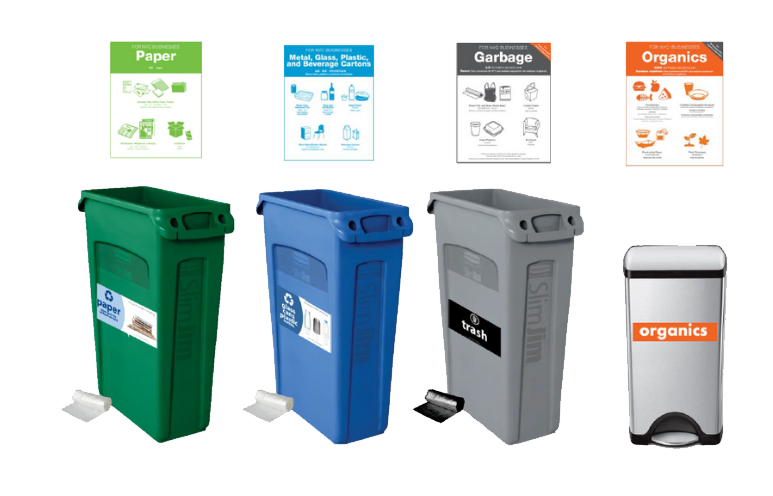
Sustainability
How to Create a Compliant Waste Program for Your Office
August 12, 2025
Effective waste management is not just about workplace maintenance and cleanliness; it is a legal requirement for businesses to prevent hefty fines for non-compliance. Waste diversion plays a crucial role in the achievement of broader sustainability goals, so organizations need to implement compliant and efficient waste systems.
ESRT’s sustainability experts help tenants achieve mutual goals and ensure that spaces remain compliant. This guide provides actionable insights on requirements, best practices for bin placement and staff training, the benefits of centralized waste systems, and tools for tenants to implement compliant systems seamlessly.
Why Waste Management Compliance Matters
Legal Obligations and the Risk of Penalties
New York City regulations mandate that businesses segregate and manage waste responsibly, and non-compliance can result in substantial fines and operational disruptions. In New York City, businesses must separate recyclables and organics from regular waste, and failure to comply can lead to considerable fines.
Materials that are legally required for recycling include:
- Cardboard
- Glass
- Mixed paper
- Metal
- Rigid plastic
- And beverage cartons.
Regulatory authorities are not just focused on enforcement; they aim to drive sustainable practices. When businesses understand and align their operations with these rules, they can not only avoid penalties but also contribute actively to environmental preservation efforts.
What Do You Need for a Compliant Waste Collection Program?

Bins
Establish three-bin stations with designated bins for mixed paper recycling, glass, metal, rigid plastic, beverage cartons, and trash. Businesses must display enough bins to collect all recyclable materials separately from trash.
Bags
All recycling bins must be lined with clear bags or collected loosely within bins. Trash must be collected in black, opaque bags. Cardboard must be flattened and bundled or bagged in clear liners.
Labels & Signage
All waste bins must be labeled to clarify which materials they hold. Detailed signage must be displayed in all areas where waste is routinely disposed.
Best Practices for Effective Waste Separation Systems

- Thoughtful Bin Placement
Waste bin locations significantly impact their use and effectiveness. Ensure the four primary waste streams – general trash, paper recycling, glass/metal/plastic recycling, and organics – have co-located bins in accessible, high-traffic areas like kitchens and bathrooms.
- Accessibility Matters: Locate bins at eye level and near workstations or meeting rooms to encourage participation.
- Standardized Color-Coding: Use recognized bin colors for recycling (blue), organics (orange), and general waste (black or gray).
- Clear and Informative Signage
Bin labels should clearly indicate what materials belong in each bin. Consistency and visual appeal can significantly influence compliance rates.
- Use Graphics: Include images of common items with clear descriptions.
- Multilingual Options: Provide directions in multiple languages.
- Downloadable Templates: Leverage online tools or sustainability toolkits that have ready-to-print, regulation-compliant signage.
- Staff Education and Training
A compliant waste system only works effectively when employees are informed and engaged. Create a waste-conscious culture through:
- Training: Incorporate waste management guidelines in employee orientation programs.
- Interactive Workshops: Host regular sessions which focus on waste regulations, sorting tips, and sustainability as a corporate value.
- Monitor and Recognize Participation: Celebrate milestones in waste diversion and engage staff with incentives like gift cards or eco-friendly rewards.
The Case for Centralized Waste Management Systems
Reduce Contamination
One of the primary challenges with waste management is contamination, where unrecyclable items are mixed with recyclables or organics, which can render entire loads unusable.
Boost Waste Diversion
Centralized systems simplify the segregation process to ensure recyclable and organic waste is processed correctly, which leads to more efficient waste diversion.
Practical Tools for Tenant Compliance
Visual tools and checklists help businesses effortlessly adhere to waste regulations. Below is a step-by-step implementation guide:
Compliance Checklist
- Evaluate Waste Streams: Conduct a detailed waste audit to identify types and quantities of waste produced.
- Set Up Proper Infrastructure: Place bins for trash, recyclables, and organics in high-usage locations.
- Label Bins Clearly: Attach regulation-compliant signage with visuals for easy identification.
- Train Regularly: Schedule quarterly workshops and set up a system to onboard new employees on waste compliance.
- Monitor and Adjust: Regularly review waste diversion metrics to identify areas of improvement.
For more information about proper waste disposal and management, please review ESRT’s Sustainability Tenant Waste Guide.
Learn more about sustainability at ESRT!
Sustainability
Flight to Quality
Fully modernized, energy efficient buildings that focus on providing our tenants with top tier amenities and a healthy environment at a lower price than the competition







